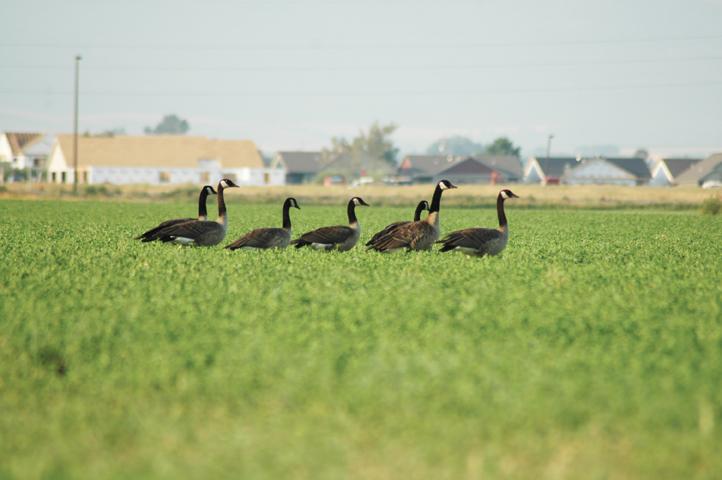Better Building
Responsible development in the midst of indulgent sprawl.
Bald eagles perched high overhead, eyeing emerging ground squirrels; the prehistoric clucking of mating sandhill cranes; white-tailed deer bounding in the waning cover of dawn. This sounds like the opening montage for Animal Planet, but it is actually the wetland habitat of Baxter Meadows subdivision in northwest Bozeman.
This 460-acre development, conceived by developer Jerry Williams, is a harbor for these and other indigenous critters because of well-planned wetland reclamation efforts. On the ground, the habitat provides havens for red foxes, Hungarian partridge, and ring-necked pheasants. The myriad small streams and two large ponds are home to mallard ducks, western grebes, Canada geese, and the occasional blue-winged teal. Surrounding both of these are large cottonwoods that various raptors use for nesting and hunting grounds.
What is ironic about all this wildlife is that at the core of it all are over 100 homes, condominiums, and the plan for several small businesses. So, when urban sprawl is on Bozeman residents’ minds and yuppified subdivisions have devoured century-old family farms, a place like Baxter Meadows seems like a gem. Although much of the vision for this area, planned on the new urbanism philosophy, originated from Williams, he ultimately hired Bozeman’s Potter Clinton Development to aid in the establishment and reconstruction of several acres of wetlands throughout the development.
Project manager Mark Meissner of Potter Clinton has brought his own appreciation of Montana’s natural habitat to the project. Meissner is an MSU graduate in construction engineering, and he brings a technical understanding of heavy equipment, the organizational skills of a manager, and the creativity and friendly respect of a young generation-Y member who seems to flow from the office to the field.
If Meissner could be considered the uncle of the Baxter Meadows wetlands, then wetland scientist Lynn Bacon with PBS & J is the matriarch of the entire ecosystem. “I have been on this project nearly a decade,” she endearingly claims. “It’s my baby.” As at home in knee-high rubber boots among 20-ton construction equipment as she is carefully kneeling beside a delicate stream, Bacon can identify every plant species in the area and knows whether it is native, nonnative, or invasive. She can also describe the behavior of all the fauna species within Baxter Meadows.
Bacon clarified one of the purposes for the apparent July 2007 construction, stating, “all the impacts done on this property are for the sake of infrastructure/roads; no one has gone in and slammed some houses on anything.” Essentially, the establishment of new infrastructure means the necessary “clipping” of existing wetlands. Federal, county, and city regulations state that these clippings need to be reclaimed at a 2:1 ratio (created wetland to impacted wetland). She adds that a wetland “has to meet criteria for hydrology, soil, and vegetation.” In Baxter Meadows there are nearly 190 acres of open space, of which over 30 acres are considered wetland.
Over ten days in July, Meissner’s crew from Sime took 1,300 linear feet of the farm canal Baxter Border Ditch, what he described as “a straight shot, basically up to Baxter [Lane],” and turned it into .6 acres of new wetland. The first day they broke ground on this section, the delicacy with which the operator placed the bucket of his 48,000 pound excavator at the stream’s edge, and combed back the top few inches of weeds was a marvel. The surgical operation of the machinery is done in a manner that Bacon describes as "like a butter knife."
Over the next couple of days, they returned the stream to a natural wandering bed, laid coconut-fiber mat seeded with native grass, and Bacon then planted several sprigs of willow, which in a year will establish roots and create nesting grounds for red wing blackbirds and other smaller migratory species.
In only three years, the area in Baxter Meadows West has become a thriving example of the potential of wetland restoration; where once an overgrown farm ditch trickled along, now a winding trout habitat thrives with deep pools and overhanging native grass. In some places Potter Clinton and Williams placed foot bridges that extend well past the riparian zone and are bedded in the earth away from the stream. Meissner states that he would prefer to “clear span” the stream, which is “much more costly but looks a lot better and doesn’t have any impact.” Bacon reinforces the importance of this bridge work because it “maintains the hydrology.”
Although many throughout the country lament the days of open ranch and farm land surrounding Bozeman, the developers have some local support. Stephen Johnson, executive director of the Gallatin Valley Land Trust, said that although they specialize in "private land conservation and community trails" and are not experts in wetland development, "wetlands can be wonderful features in parkland and it is always important to get kids exposed to nature." He did stress, however, that GVLT does not take positions on development such as the one discussed here, nor would he be qualified to comment on the expertise of such an undertaking.
Scott Bosse, river conservation coordinator for the Greater Yellowstone Coalition, has focused on establishing subdivision buffer corridors along the major watersheds of Gallatin Valley. He visited a portion of the wetland area in late August as the newly seeded stream banks began to sprout. After a half-hour walk around the wetlands and along Baxter Lane and Oak Street, Bosse made a conclusion: "Like most people around here, you'd rather not see all these old farms developed in the first place, but if we are going to grow, and Bozeman's a destination for people that have moved from all over the country," he pauses and eyes the pond for another rising trout in the hazy August sunset, "I'd like to see it done this way."
In a cautionary tone, he added, "If you look at the bigger picture, it's really important that we do this at the county level, not just the subdivision level." Rhetorically he asks, if "you look at Gallatin County, and you say 'what are our most priceless natural resources?' our rivers, our streams, our lakes, our ponds, our wetlands; let's set those aside so people can enjoy those, and at the local level let's do the same thing." However, he warns, if "you take them for granted and develop them and you figure you can just make more money doing that, then this place is going to turn into something that no one really wants."
In the evening, the ponds are dappled with sipping trout eating spinning mayflies. In addition to these aquatic insects, third-level species such as damselflies, snails, and leeches also inhabit the pond; as all fly fishermen know, leeches equate to large, healthy trout. Additionally, on any jaunt around the ponds in the summer, one might observe broods of mallard ducks, killdeer families, western grebes, pelicans, great blue herons, or the recently sighted short-billed dowitcher. To ensure that the wildlife and vegetation lasts for generations, Bacon encourages “the public to monitor the use of their public land, or any lands,” to police the areas of misuse and litter, and educate others on the appropriate activities along riparian wetland areas. Ultimately, she states, people “should enjoy and appreciate these wild microecosystems within the not-so-wild urban areas.”
Making Some Green: Story Mill gets a face-lift
For those of us accustomed to seeing Bridger View Trailer Court on N. Bridger Canyon Road, be prepared. The end is near. Residents of the trailer court have until October 2008 to be out because the Story Mill area is getting a major face-lift.
Keeping with the popular “green” theme, the Story Mill project is a vision of GoBuild, Inc., which is headquartered in Bozeman. GoBuild intends to build a residential (10% of which will be within the affordable housing plan) and commercial community on 89 acres of the land, including 34 acres of open space. The project is on track to become the first Leadership in Energy and Environmental Design (LEED) Certified Neighborhood Development in the United States. This means that the redevelopment of Story Mill will use the LEED programs to create an environmentally sound community. This vision affects everything from the design of the housing to the protection of the local wetlands. Much of the old Story Mill will remain intact and will be integrated into the new look. The whole idea is to renovate, revive, and reconnect a historic part of Bozeman’s past to today.
Public comment has been pretty positive regarding the project. The City Planning Board unanimously approved the project and at various city commission meetings, citizens’ only big concern seems to be about the increased traffic that the new community will create, but the city and the designers are taking steps to ensure smooth traffic flow. Bozeman residents seem mostly excited about building a new communityin the northeast part of town, reconnecting Story Mill to the rest of town and doing it all in an innovative, sustainable way. Check out storymillcenter.com for more details and images.
-Amber Patterson






